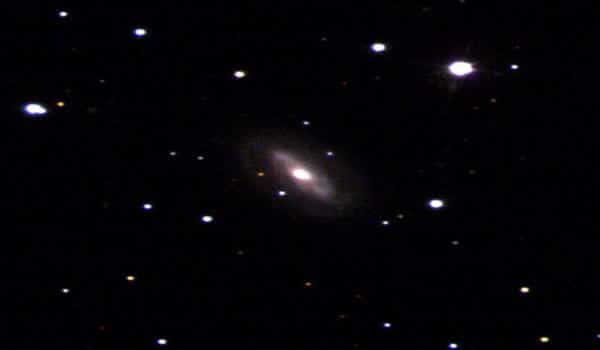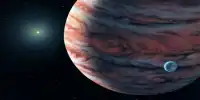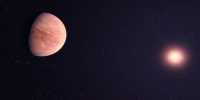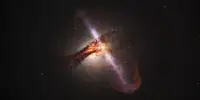Astronomers have created the best image yet of an RV Tauri variable, a rare type of stellar binary in which two stars orbit within a sprawling disk of dust, one of which is nearing the end of its life. Their 130-year dataset contains the most light ever collected for one of these systems, ranging from radio to X-rays.
“In the Milky Way galaxy, there are only about 300 known RV Tauri variables,” said Laura Vega, a recent doctoral recipient at Vanderbilt University in Nashville, Tennessee. “We concentrated our research on the second brightest, named U Monocerotis, which is now the first of these systems to detect X-rays.”
The Astrophysical Journal published a paper describing the findings, led by Vega. The system, known as U Mon for short, is located approximately 3,600 light-years away in the constellation Monoceros. Its two stars orbit each other every six and a half years on an orbit that is tipped about 75 degrees from our perspective.
Astronomers have painted their best picture yet of an RV Tauri variable, a rare type of stellar binary where two stars – one approaching the end of its life – orbit within a sprawling disk of dust.
The primary star, an elderly yellow supergiant, has roughly twice the mass of the Sun but has ballooned to 100 times its size. A tug of war between pressure and temperature in its atmosphere causes it to expand and contract on a regular basis, and these pulsations produce predictable brightness changes with alternating deep and shallow dips in light – a feature of RV Tauri systems. Scientists know less about the companion star, but they believe it is of similar mass to the primary and much younger.
The cool disk that surrounds both stars is made up of gas and dust that was ejected by the primary star as it evolved. Vega’s team estimated the disk’s size to be around 51 billion miles (82 billion kilometers) across using radio observations from the Submillimeter Array on Maunakea, Hawai’i. The binary orbits within a central gap that the scientists believe is comparable to the distance between the two stars at their maximum separation, which is approximately 540 million miles (870 million kilometers).
When the stars are the furthest apart, they are roughly aligned with our line of sight. The disk partially obscures the primary, causing another predictable fluctuation in the light of the system. Vega and her colleagues believe this occurs when one or both stars interact with the disk’s inner edge, sucking streams of gas and dust away. They propose that the companion star funnels the gas into its own disk, which heats up and produces an X-ray-emitting gas outflow. This model could account for X-rays detected by the European Space Agency’s XMM-Newton satellite in 2016.

“The XMM observations make U Mon the first RV Tauri variable detected in X-rays,” said Kim Weaver, an astrophysicist at NASA’s Goddard Space Flight Center in Greenbelt, Maryland. “It’s exciting to see ground- and space-based multiwavelength measurements collide to provide us with new insights into a long-studied system.”
Vega’s team also used 130 years of visible light observations in their analysis of U Mon. The earliest available measurement of the system came from the archives of the American Association of Variable Star Observers (AAVSO), an international network of amateur and professional astronomers based in Cambridge, Massachusetts. AAVSO also provided additional historical measurements spanning the mid-1940s to the present.
The researchers also used images cataloged by the Digital Access to a Sky Century @ Harvard (DASCH), a program at the Harvard College Observatory in Cambridge dedicated to digitizing astronomical images from glass photographic plates made by ground-based telescopes between the 1880s and 1990s.
The light from U Mon varies because the primary star pulsates and the disk partially obscures it every 6.5 years or so. Using the combined AAVSO and DASCH data, Vega and her colleagues discovered an even longer cycle in which the system’s brightness rises and falls every 60 years. They believe that this extra variation in orbit is caused by a warp or clump in the disk located about as far from the binary as Neptune is from the Sun.
Vega completed her analysis of the U Mon system as a NASA Harriett G. Jenkins Predoctoral Fellow, a program funded by the Minority University Research and Education Project of the NASA Office of STEM Engagement.
“Laura used this historical dataset for her doctoral dissertation to detect a characteristic that would otherwise appear only once in an astronomer’s career,” said co-author Rodolfo Montez Jr., an astrophysicist at Cambridge’s Center for Astrophysics | Harvard & Smithsonian. “It demonstrates how our understanding of the universe grows over time.”
Co-author Keivan Stassun, a star formation expert and Vega’s doctoral advisor at Vanderbilt, observes that this evolved system shares many characteristics and behaviors with newly formed binaries. Both are embedded in gas and dust disks, draw material from those disks, and produce gas outflows. And the disks can form warps or clumps in both cases. These could be the first signs of planet formation in young binaries.
“We still have questions about the feature in U Mon’s disk, which future radio observations may answer,” Stassun said. “However, many of the same characteristics exist. It’s fascinating to see how closely these two binary life stages mirror one another.”















